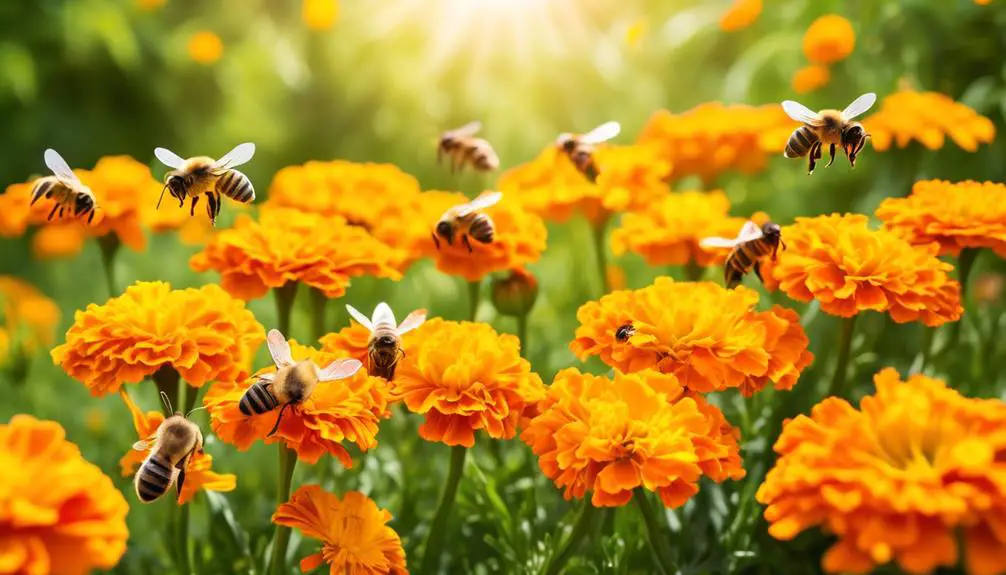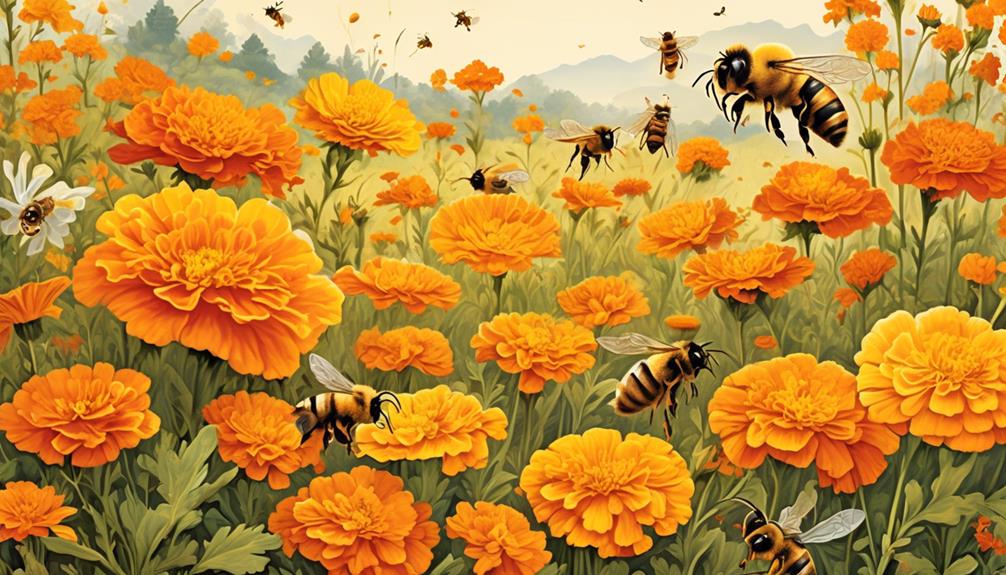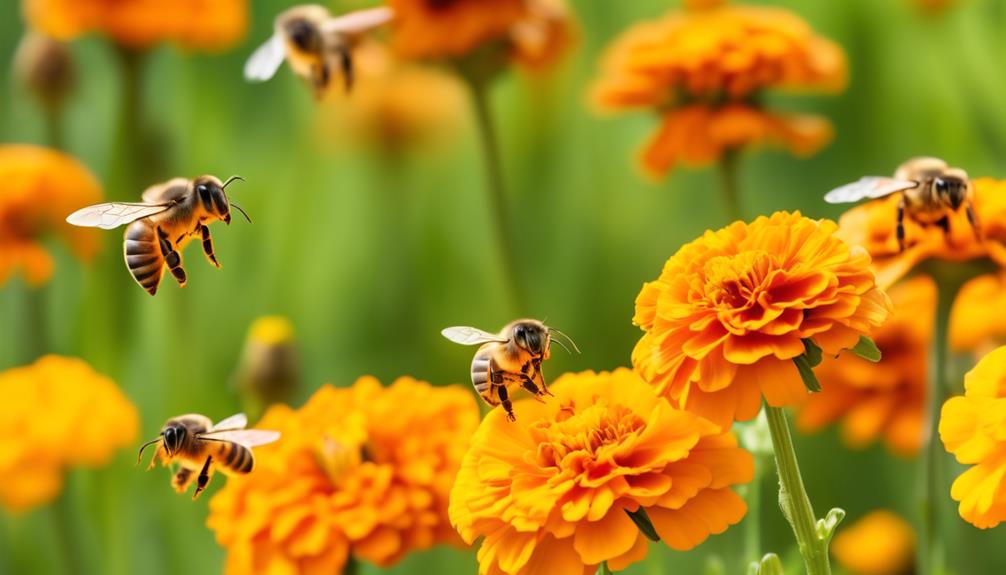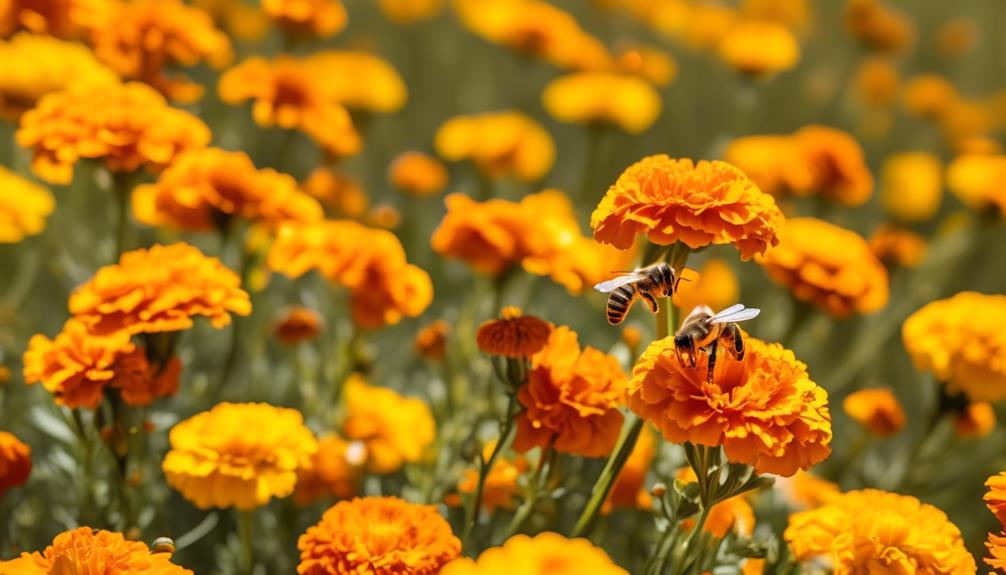Observe the fascinating dynamic between bees and marigolds, and uncover whether these vibrant flowers are a favorite in the bee community.

Do Bees Like Marigolds?
You've likely heard the phrase 'busy as a bee,' but have you ever wondered about the intricacies of a bee's workday?
Specifically, the relationship between bees and marigolds, a common flower in many gardens. Marigolds, with their vibrant hues and distinctive scent, certainly catch our attention, but do they have the same effect on bees?
You'll be surprised to learn how these small creatures interact with marigolds and whether these flowers are a hit or a miss in the bee community.
Intrigued? Let's explore this fascinating topic further.
Key Takeaways
- Marigolds are highly attractive to bees due to their ability to reflect ultraviolet light, vibrant colors, and strong aroma.
- Marigolds serve as a pollinator's paradise, attracting various pollinators such as bees, butterflies, and hummingbirds with their bright colors, potent scent, and abundant nectar and pollen.
- Bees interact with marigolds by landing on the petals, exploring the flower for nectar, and facilitating cross-pollination through pollen sticking to their bodies.
- Marigolds have a significant impact on bee behavior, attracting bees from long distances, providing vital energy through nectar, promoting foraging skills, and reinforcing steady foraging patterns.
Understanding the Bee-Marigold Relationship

To fully grasp the intricate relationship between bees and marigolds, it's crucial to delve into the specific characteristics of marigolds that attract these pollinators. Marigolds, scientifically known as Tagetes, are both dazzling to our eyes and enticing to bees. Why? It's their vibrant colors and potent fragrance, which are prime bee attractants.
You'd be fascinated to know that bees, unlike us, see the color spectrum differently. They're drawn to flowers like marigolds that reflect ultraviolet light. This perception guides bees to the flower's nectar, ensuring efficient pollination. Besides the color, marigolds produce a strong aroma, serving a dual purpose. Firstly, it lures bees from afar, acting like a botanical beacon. Secondly, it repels certain pests due to its unique chemical composition.
The marigold's structure also plays a significant role. Its flat, daisy-like form provides an accessible landing platform for bees. Likewise, the high nectar and pollen content in marigolds is a bee feast that shouldn't be overlooked.
Marigolds: A Pollinator's Paradise?

So, you might be wondering, can we consider marigolds as a pollinator's paradise? The answer is a resounding yes, but it's not just the bees that are drawn to these vibrant flowers.
Marigolds, scientifically known as Tagetes, are known to attract a variety of pollinators due to their bright colors and potent scent. Their rich, golden petals act as a beacon for bees, butterflies, and even hummingbirds. But it's not just the aesthetics that pull these pollinators in; it's also the abundance of nectar and pollen tucked within the flower's intricate structure.
The marigold's composite structure, characterized by a dense cluster of tiny individual flowers, or florets, is a veritable buffet for pollinators. Each floret offers up a sip of nectar and a dusting of pollen, providing a rich and convenient source of nutrition. Additionally, marigolds have a prolonged flowering period, ensuring a consistent food supply for these critters throughout the growing season.
In an ecological context, marigolds perform a vital role in supporting pollinator populations. They're not just pretty to look at; they're a lifeline for these creatures. Hence, it's fair to say that marigolds indeed constitute a pollinator's paradise.
How Bees Interact With Marigolds

When bees encounter marigolds, there's a fascinating interaction that unfolds, driven by the bee's keen search for nectar and the marigold's alluring display of vibrant colors and intoxicating scent. The bee, guided by ultraviolet vision and an exceptional sense of smell, is attracted to the marigold's warm hues and fragrance.
As you observe closely, you'll notice the bee approaching the flower, its antennae twitching as it hones in on its target. It lands on the marigold's petal, which acts like a landing pad, and begins to explore the flower for nectar, a rich source of energy. Their specific anatomy allows them to navigate the intricate structure of the flower – their long, slender tongues, or proboscis, probe the flower's nectar guides, accessing the sweet reward.
This interaction isn't one-sided, though. The marigold benefits from the bee's visitation too. As the bee forages, pollen from the marigold's anthers sticks to its fuzzy body. Later, when the bee visits another marigold, some of this pollen is transferred, facilitating cross-pollination and ensuring the survival of the plant species. It's a mutually beneficial relationship, a marvel of nature's symbiosis.
The Impact of Marigolds on Bee Behavior

Building on this symbiotic relationship, you'll find that marigolds not only attract bees but also significantly impact their behavior. The bright colors and strong scent of marigolds serve as powerful attractants for bees, drawing them in from significant distances.
Once the bees arrive, they're not just passive visitors. The marigolds' nectar, rich in sugars, provides them with vital energy. It also influences the bees' foraging habits. Your observation may reveal that bees visiting marigolds tend to forage longer and return to the same flower repeatedly, a behavior termed as floral fidelity. Marigolds, being prolific bloomers, ensure a steady supply of nectar, reinforcing this behavior.
Interestingly, the physical interaction with marigolds also impacts bee behavior. The shape and structure of marigold flowers, particularly the tube-like florets, require bees to adapt their foraging techniques. You'll notice that bees need to maneuver skillfully to access the nectar, promoting the development of sophisticated foraging skills.
Enhancing Bee Attraction With Marigolds

To enhance the attraction of bees using marigolds, it's essential to understand the specific characteristics of these flowers that appeal to our buzzing friends.
Marigolds, known scientifically as Tagetes, are rich in nectar and pollen, two crucial food sources for bees. These vibrant flowers also emit a strong fragrance that bees find irresistible, acting as a natural beacon to draw them in.
When planting marigolds, it's important to consider the variety. The single-flower type, with one row of petals, is particularly attractive to bees as it provides easier access to nectar and pollen. Also, you should plant marigolds in clusters rather than individually. This not only creates a more considerable, more visible target for bees but also allows for efficient foraging.
Frequently Asked Questions
What Other Types of Flowers Do Bees Typically Prefer?
You're curious about what flowers bees prefer, aren't you?
Bees typically gravitate towards bright, fragrant flowers with ample nectar. They're particularly fond of flowers like sunflowers, coneflowers, and lavender. They also love flowering herbs like rosemary and thyme.
It's fascinating how these flowers' vivid colors and strong scents attract bees. Providing a variety of these in your garden can help support local bee populations.
How Can Marigolds Benefit a Home Garden, Aside From Attracting Bees?
You're probably wondering how marigolds can benefit your home garden, aside from attracting bees.
Well, marigolds are known for their pest repelling properties. They can deter nematodes, tiny soil-dwelling pests, and other insects.
They're also easy to grow and maintain. Plus, their vibrant colors can brighten up any garden space.
What Are the Potential Negative Impacts of Bees on Marigolds?
While you might worry about bees harming your marigolds, they're generally beneficial. Bees pollinate flowers, which helps them reproduce.
However, in large numbers, bees could potentially lead to over-pollination. This isn't usually a problem, but it can cause plant stress and decreased flower production.
Also, if a hive chooses your marigold patch for a home, it could lead to a dangerous situation for you or your pets.
How Do Marigolds Impact the Overall Health and Lifespan of Bees?
Marigolds can significantly impact bees' health and lifespan. They're rich in nectar and pollen, providing essential nutrients for bees. Their bright colors attract bees, aiding in their foraging.
However, marigolds can also expose bees to pesticides if they're not organically grown. Prolonged exposure can harm bees' health, reducing their lifespan.
Are There Any Specific Types of Bees That Are More Attracted to Marigolds Than Others?
You're asking if certain bee types prefer marigolds over others. It's not that straightforward.
All bees can be attracted to marigolds due to their bright colors and abundant nectar. However, certain bees like the honeybee and bumblebee may be more drawn to them.
They're more efficient at extracting nectar from disk flowers, which marigolds have. It's not a strict preference, but a matter of efficiency and benefit.
Conclusion
In conclusion, you've seen how marigolds can significantly impact bee behavior. These vibrant flowers aren't just a visual delight – they're a bee magnet, offering nectar and pollen. Bees are drawn to marigolds, interacting frequently and effectively with them.
So, if you're looking to enhance bee attraction in your garden, planting marigolds is a scientifically-backed, effective strategy. Remember, supporting our buzzing friends is crucial for our environment's health and sustainability.



